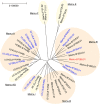Lipopeptides: a novel antigen repertoire presented by major histocompatibility complex class I molecules
- PMID: 27402593
- PMCID: PMC5011682
- DOI: 10.1111/imm.12646
Lipopeptides: a novel antigen repertoire presented by major histocompatibility complex class I molecules
Abstract
Post-translationally modified peptides, such as those containing either phosphorylated or O-glycosylated serine/threonine residues, may be presented to cytotoxic T lymphocytes (CTLs) by MHC class I molecules. Most of these modified peptides are captured in the MHC class I groove in a similar manner to that for unmodified peptides. N-Myristoylated 5-mer lipopeptides have recently been identified as a novel chemical class of MHC class I-presented antigens. The rhesus classical MHC class I allele, Mamu-B*098, was found to be capable of binding N-myristoylated lipopeptides and presenting them to CTLs. A high-resolution X-ray crystallographic analysis of the Mamu-B*098:lipopeptide complex revealed that the myristic group as well as conserved C-terminal serine residue of the lipopeptide ligand functioned as anchors, whereas the short stretch of three amino acid residues located in the middle of the lipopeptides was only exposed externally with the potential to interact directly with specific T-cell receptors. Therefore, the modes of lipopeptide-ligand interactions with MHC class I and with T-cell receptors are novel and fundamentally distinct from that for MHC class I-presented peptides. Another lipopeptide-presenting MHC class I allele has now been identified, leading us to the prediction that MHC class I molecules may be separated on a functional basis into two groups: one presenting long peptides and the other presenting short lipopeptides. Since the N-myristoylation of viral proteins is often linked to pathogenesis, CTLs capable of sensing N-myristoylation may serve to control pathogenic viruses, raising the possibility for the development of a new type of lipopeptide vaccine.
Keywords: antigen presentation/processing; major histocompatibility complex; structural biology/crystallography.
© 2016 John Wiley & Sons Ltd.
Figures



Similar articles
-
Identification and Structure of an MHC Class I-Encoded Protein with the Potential to Present N-Myristoylated 4-mer Peptides to T Cells.J Immunol. 2019 Jun 15;202(12):3349-3358. doi: 10.4049/jimmunol.1900087. Epub 2019 May 1. J Immunol. 2019. PMID: 31043477
-
TAP-independent induction of N-myristoylated lipopeptide-specific CTLs in transgenic mice expressing the rhesus MHC class I allomorph, Mamu-B*098.J Immunol. 2025 Jul 1;214(7):1483-1492. doi: 10.1093/jimmun/vkaf082. J Immunol. 2025. PMID: 40334079
-
Crystal structure of the N-myristoylated lipopeptide-bound MHC class I complex.Nat Commun. 2016 Jan 13;7:10356. doi: 10.1038/ncomms10356. Nat Commun. 2016. PMID: 26758274 Free PMC article.
-
Viral interference with MHC class I antigen presentation pathway: the battle continues.Vet Immunol Immunopathol. 2005 Aug 15;107(1-2):1-15. doi: 10.1016/j.vetimm.2005.04.006. Vet Immunol Immunopathol. 2005. PMID: 15978672 Review.
-
Pathways of viral antigen processing and presentation to CTL: defined by the mode of virus entry?Immunol Today. 1989 Feb;10(2):45-8. doi: 10.1016/0167-5699(89)90303-4. Immunol Today. 1989. PMID: 2665772 Review.
Cited by
-
Ligand Recognition by the Macrophage Galactose-Type C-Type Lectin: Self or Non-Self?-A Way to Trick the Host's Immune System.Int J Mol Sci. 2023 Dec 3;24(23):17078. doi: 10.3390/ijms242317078. Int J Mol Sci. 2023. PMID: 38069400 Free PMC article. Review.
-
Molecular basis for presentation of N-myristoylated peptides by the chicken YF1∗7.1 molecule.J Biol Chem. 2025 Jul;301(7):110253. doi: 10.1016/j.jbc.2025.110253. Epub 2025 May 22. J Biol Chem. 2025. PMID: 40412526 Free PMC article.
-
Hydrophobic Mycobacterial Antigens Elicit Polyfunctional T Cells in Mycobacterium bovis Immunized Cattle: Association With Protection Against Challenge?Front Immunol. 2020 Nov 12;11:588180. doi: 10.3389/fimmu.2020.588180. eCollection 2020. Front Immunol. 2020. PMID: 33281817 Free PMC article.
-
Crystal structures of lysophospholipid-bound MHC class I molecules.J Biol Chem. 2020 May 15;295(20):6983-6991. doi: 10.1074/jbc.RA119.011932. Epub 2020 Apr 8. J Biol Chem. 2020. PMID: 32269076 Free PMC article.
-
Structural aspects of chemical modifications in the MHC-restricted immunopeptidome; Implications for immune recognition.Front Chem. 2022 Aug 9;10:861609. doi: 10.3389/fchem.2022.861609. eCollection 2022. Front Chem. 2022. PMID: 36017166 Free PMC article. Review.
References
-
- Neefjes J, Jongsma ML, Paul P, Bakke O. Towards a systems understanding of MHC class I and MHC class II antigen presentation. Nat Rev Immunol 2011; 11:823–36. - PubMed
-
- Van Kaer L, Ashton‐Rickardt PG, Ploegh HL, Tonegawa S. TAP1 mutant mice are deficient in antigen presentation, surface class I molecules, and CD4–8+ T cells. Cell 1992; 71:1205–14. - PubMed
-
- Harty JT, Bevan MJ. Responses of CD8+ T cells to intracellular bacteria. Curr Opin Immunol 1999; 11:89–93. - PubMed
Publication types
MeSH terms
Substances
LinkOut - more resources
Full Text Sources
Other Literature Sources
Medical
Research Materials
Miscellaneous

